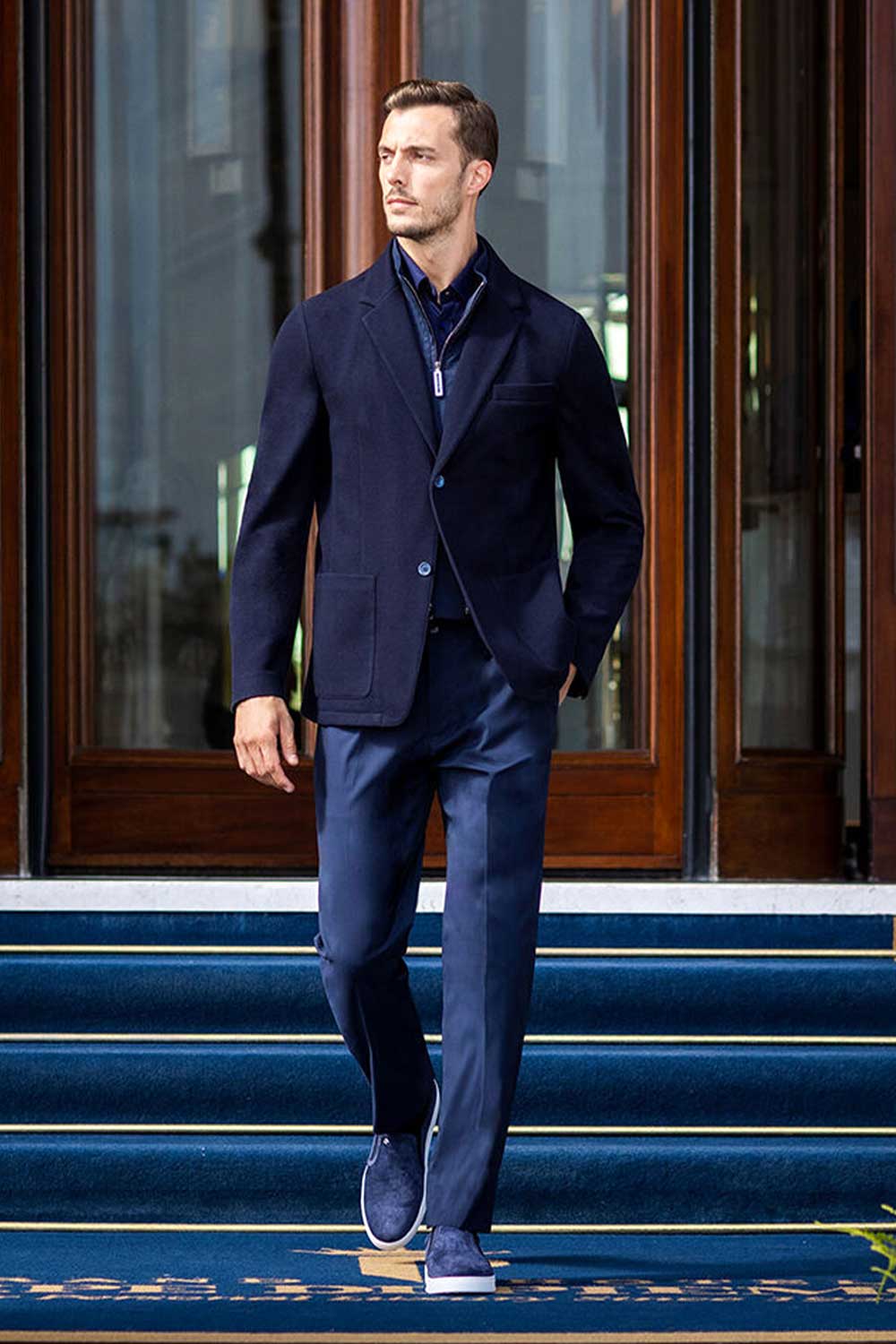
With jackets starting at a jaw-dropping $6,000 (about £4,500) and suits at $7,000 (close to £5,500), and accessories like crocodile leather boots fetching $11,500 (around £9,000), you might wonder: why is Stefano Ricci SO expensive? And how could Stefano Ricci worth such eye-watering cost?
Let’s delve into the world of Stefano Ricci to uncover what truly lies behind those price tags that could make even the most seasoned luxury shopper pause.
Stefano Ricci’s Rich Heritage
Stefano Ricci’s journey from a small Florentine tie maker to a global luxury powerhouse is nothing short of remarkable.
Founded in 1972 by the eponymous designer and his wife Claudia, the brand initially focused on neckties, transforming them from mere accessories into the protagonists of men’s wardrobes.
By 1974, Ricci’s innovative designs were already gracing the shelves of prestigious stores like Neiman Marcus and Harrods.
This early success laid the foundation for what would become a vertically integrated luxury empire, spanning from shirts and suits to home furnishings and even yacht interiors.
The company’s commitment to Italian craftsmanship was cemented in 2010 with the acquisition of Antico Setificio Fiorentino, a historic silk mill operating since 1786.
This move ensured Stefano Ricci’s access to some of the finest fabrics in the world, but it also significantly increased production costs—a factor that directly contributes to the brand’s high prices.
Craftsmanship As the Cornerstone of Stefano Ricci’s Luxury Pricing
Italian Tailoring
At the heart of Stefano Ricci’s stratospheric pricing lies its unwavering commitment to traditional Italian craftsmanship.
Each garment is meticulously handcrafted in Florence by artisans with decades of experience.
The company’s CEO, Niccolò Ricci, puts it bluntly,
“We sell to people that have got everything.”
This clientele expects nothing less than perfection, and Stefano Ricci delivers—at a cost.
The brand employs specialists who, in Stefano’s words,
“want to make the inside of a jacket more beautiful than the outside.”
This level of detail and craftsmanship is time-consuming and expensive, directly impacting the final price of each item.
Rare and Exotic Materials
Stefano Ricci doesn’t just use high-quality materials; it seeks out the rarest and most luxurious fabrics and leathers in the world.
From vicuña wool (which can only be shorn once every three years) to crocodile and ostrich leathers, the materials alone can cost a small fortune.
Stefano Ricci’s accessories, such as the brand’s famous diamond-encrusted, 18-karat gold belt buckle, priced at $124,000 (£95,000), paired with a $2,800 (£2,150) crocodile belt, are wearable works of art crafted from materials that are both scarce and difficult to work with.
The use of such exclusive materials inevitably drives up the cost of production and, consequently, the retail price.
Attention to Detail
Every aspect of a Stefano Ricci garment receives painstaking attention.
For instance, brand’s recent collection included suits with gold thread linings and ruthenium buttons.
Such extravagant details are a testament to the brand’s philosophy that luxury should permeate every aspect of a garment, visible or not.
Stefano Ricci’s Exclusivity Factor
Exclusivity is a key factor in Stefano Ricci’s pricing strategy.
The brand produces extremely limited quantities of each design.
As Filippo Ricci, the Creative Director, explains,
“When you do 60 metres on a fabric, that means you have 20 suits around the world with that [design]. Most of the time 10 suits are made, so the chance that you will find another gentleman around dressed like you, it’s almost impossible.”
Stefano Ricci’s scarcity appeals to the brand’s ultra-wealthy clientele who value uniqueness above all else.
It’s not unheard of for Stefano Ricci to create a single, bespoke item for a client, for example a bright yellow crocodile trench coat to match a customer’s Harley Davidson.
Moreover, the brand takes exclusivity to another level by destroying unsold merchandise at the end of each year.
In 2018, Stefano Ricci incinerated around £1.6 million worth of unsaleable products.
While this practice has faced criticism for its environmental implications, it serves to maintain the brand’s exclusivity and prevent discounting, which the company views as disrespectful to its high-paying customers.
Stefano Ricci’s Bespoke Experience
When you’re paying five digits for a suit, you expect more than just a fitting – you expect an experience.
Stefano Ricci delivers this in spades, offering a level of personal service that goes far beyond the norm.
The brand’s boutiques are designed to make clients feel “powerful and strong,” as Filippo Ricci puts it.
From the polished black briar-root wood interiors to the crocodile skin armchairs, every aspect of the shopping experience is curated to justify the hefty price tags.
But the personalised service doesn’t stop at the boutique door.
Stefano Ricci has been known to send tailors around the world to cater to individual clients.
In one extreme case, a businessman was followed around the globe by a Stefano Ricci tailor for six months before placing an order for 50 suits—a cool half-million pounds in sales.
This level of dedication and personal attention comes at a premium, but for the brand’s clientele, it’s an integral part of the luxury experience they’re paying for.
Beyond Clothing – The Stefano Ricci Lifestyle
Stefano Ricci isn’t just selling clothes; it’s selling a lifestyle. The brand has expanded into home furnishings, fragrances, and even fine wines and branded cigars.
This diversification allows the company to offer a complete luxury experience, from the suit you wear to the chair you sit in and the cigar you smoke.
The pinnacle of this lifestyle offering is perhaps the Stefano Ricci Mansion in Shanghai—a 22,000 square foot private club accessible only to customers who spend more than $100,000 a year with the brand.
This exclusive space offers everything from high-quality cigars to Italian dishes prepared by Florentine chefs.
By creating this all-encompassing luxury world, Stefano Ricci justifies its high prices not just through individual products, but through the promise of entry into an ultra-exclusive club of wealth and refinement.
No Discounts, No Compromises
One of the most controversial aspects of Stefano Ricci’s pricing strategy is its strict no-discount policy.
The brand never offers sales or markdowns, preferring to destroy unsold inventory rather than reduce prices.
While this practice has faced criticism, particularly on environmental grounds, it serves a specific purpose in maintaining the brand’s perceived value.
As Niccolò Ricci explains,
“If a customer buys a suit at one price and two weeks later it goes on sale, the sale price becomes the new price of the item in the customer’s mind.”
This uncompromising approach to pricing ensures that the value of Stefano Ricci products remains consistent, both for the brand and its customers.
It’s a bold strategy that contributes to the high prices, but also reinforces the brand’s position in the ultra-luxury market.
Stefano Ricci Celebrity Clientele
While Stefano Ricci doesn’t rely on celebrity endorsements – in fact, the brand proudly states that celebrities often want their clothes for free – it has dressed its fair share of high-profile individuals.
Tom Cruise, Andrea Bocelli, and even Nelson Mandela have worn Stefano Ricci.
However, the brand’s true celebrity lies in its less public, but incredibly wealthy, client base.
From self-made millionaires to billionaires, Stefano Ricci caters to those who, in Niccolò Ricci’s words,
“do not look at celebrities or influencers and are very proud of what they have achieved.”
This clientele, hailing from growing economies, sees Stefano Ricci as a way to flaunt their status.
The brand’s high prices, therefore, are not just a reflection of quality and craftsmanship, but also of the social cachet they provide to a very specific, ultra-wealthy demographic.
Is Stefano Ricci Worth the High Price Tag?
For those who value exclusivity and craftsmanship above all else and for whom money is no object the answer may well be yes.
The brand offers a level of quality, personalisation, and exclusivity that is hard to match.
Each garment is a masterpiece of tailoring, crafted from the finest materials by skilled artisans.
The shopping experience itself is luxurious and highly personalised, and the brand’s no-discount policy ensures that the value of each purchase is maintained.
However, it’s crucial to note that much of Stefano Ricci’s value lies in its exclusivity and the status it confers.
If these aspects aren’t important to you, or if you’re looking for pure functionality in your clothing, the astronomical prices may be hard to justify.
Conclusion
Stefano Ricci’s high prices are a result of a perfect storm of factors: unparalleled craftsmanship, rare materials, limited production, personalised service, and a steadfast commitment to maintaining exclusivity.
The brand has positioned itself at the very pinnacle of luxury menswear, catering to a clientele for whom price is secondary to quality, exclusivity, and status.
Whether Stefano Ricci is “worth it” depends entirely on your personal values, financial situation, and what you seek from your clothing.
If you’re after the absolute finest in tailoring, materials, and personalised service, and you have the means to afford it, Stefano Ricci offers a luxury experience that few can match.
However, it’s worth remembering that at these price points, you’re not just paying for a suit or a pair of shoes. You’re buying into a lifestyle, a statement of wealth and success, and entry into an ultra-exclusive club.
Whether that’s worth the price tag is a decision only you can make.



